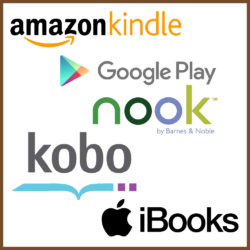 Part I ~ Part II ~ Part III – Part IV
Part I ~ Part II ~ Part III – Part IV
There are roughly fifteen “I don’t mean this” jokes about going wide. None of mine are that funny, so I’ll jump right into the author-speak version of what going wide means: the distribution of an ebook across multiple retailers.
First things first. Why is this a question? Why would an author (and I’m focusing particularly on indie authors who have to make lots of decisions like this) go “narrow”, if going wide is an option? Why would an author purposefully choose to limit ebook sales to a single marketplace, when potential readers are distributed across many different retailers?
The answer is marketshare and incentives. Amazon is radically dominant in the ebook space and offers incentives to authors who publish exclusively to the Amazon marketplace. The Amazon Select program is the “going narrow” option that is the alternative to going wide. Kindle ebooks enrolled in Amazon Select for a three-month term are included in the Kindle Unlimited (KU) program.
KU has been described as a Netflix for books. For a flat monthly fee, subscribers can read any number of books enrolled in the program. If you want to learn more about KU from the reader point-of-view, go try it out with a free trial by clicking this associate link and helping me make some sweet moolah (and if that pop culture reference shot right past you, stop reading this and go watch Napoleon Dynamite).
Authors in Amazon Select are paid for the number of pages read in KU. It’s not a high rate per page, but it can be a significant source of income. I may break down the economics of KU in a future post and explain why it can make a lot of sense, but the critical factor underlying the relevance of Amazon Select, of “going narrow”, is scale.
Put simply, if you split normal Amazon Kindle sales and Kindle Unlimited into two entities, Kindle Unlimited is one of the largest ebook retailers on the planet. It overshadows all the other retailers in most of the major markets. You can read up on the market share picture in early 2017 here.
(Aside: Another key aspect that I won’t go into here that is incredibly important is the lowered barrier to entry for new authors in KU. Readers don’t have to pay any incremental cost to read your book. That lowers the threshold for them to try new authors.)
I don’t mean to imply authors shouldn’t go wide. Rather, I want to explain why it is even a question. Indie authors have to be writers and business people. They need to answer complex financial questions for their specific brand—how much to budget for editing, proof-reading, cover design / illustration, etc… and whether Amazon Select or going wide is the better option.
I think that sets the scene, so I’m going to call it a wrap on Part 1. I’ve got numerous ideas for Part 2 and beyond, but drop questions in the comments if you want to make sure I address specific issues.


I love the Napoleon Dynamite reference! HAHAHAHA!!!!
It’s required watching in my household!